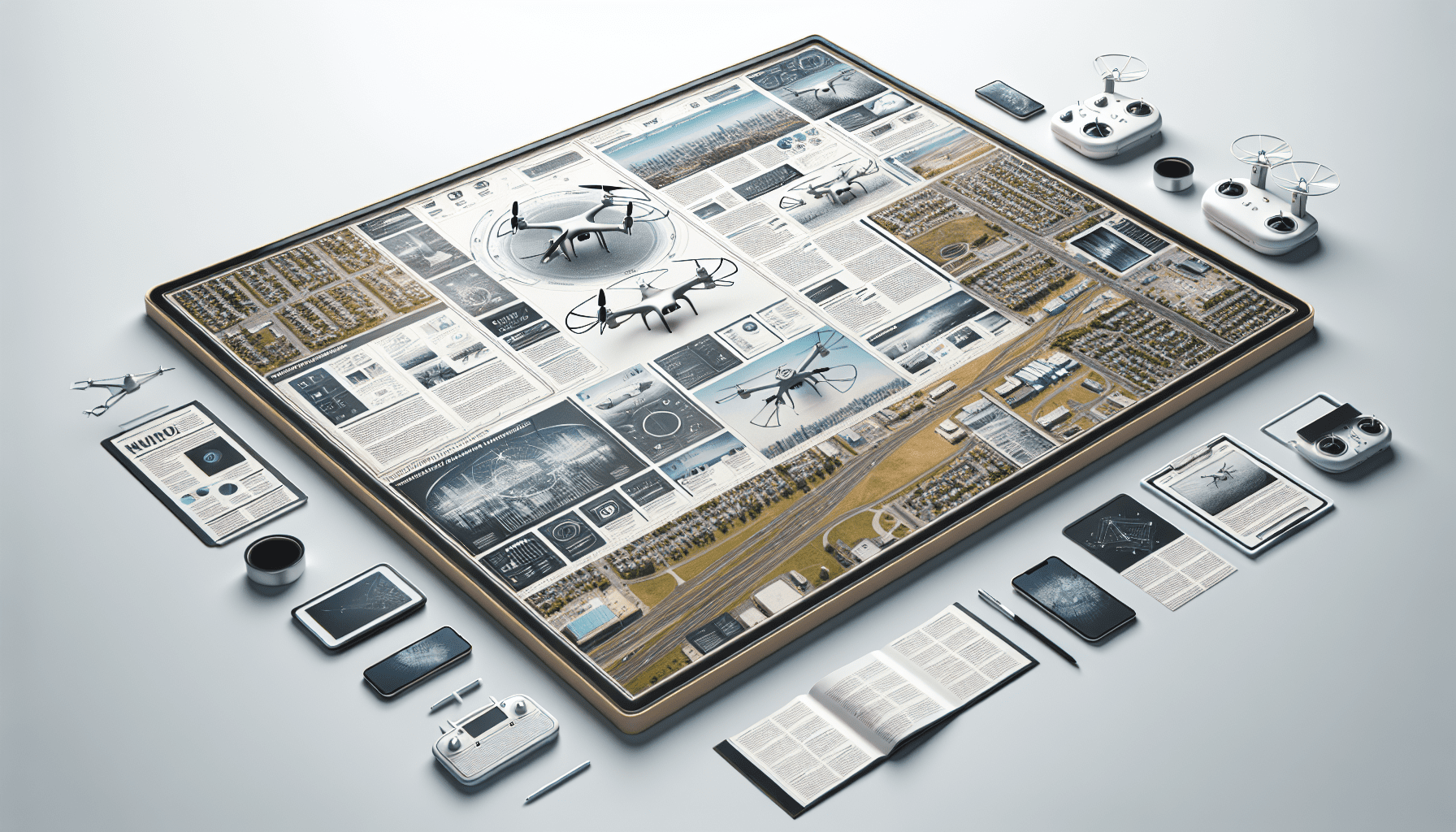Drone Marketing Strategies That Capture Audience Attention
In This Article
- Drone marketing offers cost-effective, cinematic visuals that boost engagement and conversions.
- Effective aerial content enhances brand storytelling and immerses viewers in a unique experience.
- Successful campaigns require compliance with local regulations and thoughtful integration into digital strategies.
- Selecting the right drone and operator is critical to achieving high-quality outputs.
- Technological advancements will continue to expand the boundaries of what’s possible in drone-based advertising.
How Drone Marketing Is Changing the Industry
The Shift Toward Aerial Engagement
Drone marketing is transforming the landscape of modern advertising by adding a new, visually compelling dimension to brand storytelling. With the ability to capture high-quality aerial footage and dynamic perspectives, drones enable brands to engage audiences like never before. The integration of drone technology into marketing strategies is driving innovation across sectors—from real estate and tourism to entertainment and events. As businesses strive to cut through digital noise and connect with increasingly distracted consumers, drone marketing offers an unparalleled method to stand out through immersive content and experiential campaigns.

Benefits of Using Drones in Advertising
Cost Efficiency and High Impact
One of the most compelling advantages of drone marketing is its ability to deliver high production value at a fraction of the cost of traditional aerial methods. Hiring helicopters and camera crews used to be prohibitively expensive and logistically complex. Today, even small marketing teams can deploy drones to capture stunning footage, making high-end visuals more accessible than ever. In addition to cost savings, drone content garners high engagement on social media platforms due to its cinematic quality and unique perspective. This translates to superior return on investment in content marketing strategies.
“Drones are democratising cinematic storytelling by giving brands breathtaking visuals without Hollywood budgets.”
Creating Immersive Experiences with Aerial Content
Drone marketing excels in creating immersive brand experiences, offering dynamic views and emotional storytelling that ground-based cameras simply cannot achieve. Aerial content adds drama and scale, inviting viewers into the scene from an elevated perspective. Whether showcasing a sprawling resort, capturing the frantic excitement of a live concert, or documenting humanitarian efforts in hard-to-reach locations, drone footage creates a more visceral connection.
Immersive content drives higher viewer retention. According to recent studies, videos containing drone footage result in 30% longer average view times compared to standard videos. This increased engagement leads to better brand recall, which is essential in competitive markets. When paired with augmented reality (AR) and virtual reality (VR), drone footage can be further enriched to deliver even more captivating interactive experiences.
Stats That Prove Drone Marketing Works
Hard data backs up the creative momentum of drone marketing. A 2023 report by the Global Drone Marketing Association revealed that campaigns incorporating drone footage experience an average 25% increase in click-through rates on digital ads. In ecommerce, product videos enhanced with drone visuals garnered 18% more conversions. Additionally, social media posts featuring drone photography reportedly achieve twice the engagement versus standard imagery.
Notably, real estate listings with drone videos receive 403% more inquiries compared to those without, according to the National Association of Realtors. The construction industry has also embraced drone marketing for stakeholder communication, securing more investment after showcasing complex builds via drone panoramas. These statistics highlight the tangible business value of integrating drones into advertising strategies.
Best Use Cases: Real Brands, Real Results
Numerous global brands have already reaped the rewards of drone marketing. For example, Red Bull has famously captured heart-racing footage of extreme sports using drones, amplifying their brand identity rooted in adrenaline and energy. Tourism Australia used sweeping drone vistas of its coastline and national parks to revitalise its global campaign “There’s Nothing Like Australia”, leading to a 22% uptick in travel bookings from overseas markets.
Even smaller brands have seen measurable impact. An indie fashion brand in the UK documented its countryside photo shoots with drone videos, resulting in a viral social media campaign that boosted site traffic by over 300%. In hospitality, boutique hotels increasingly feature drone tours of their properties, allowing potential guests to visualise their experience before booking—thereby increasing conversions and customer confidence.
Regulatory Considerations When Flying for Ads
As drone marketing grows, so too do the regulatory frameworks surrounding it. In the UK, drone usage is governed by the Civil Aviation Authority (CAA). Any commercial drone activity, including advertising, requires an operational authorisation under the UKPDRA01 or GVC based on drone weight and use case. Failing to obtain proper licensing can result in hefty fines and disqualification from future commercial campaigns.
Brands must also be mindful of privacy laws, particularly when filming in urban or populated areas. Explicit consent may be required if individuals are identifiable. Adherence to no-fly zones, such as near airports and restricted sites, is also non-negotiable. To mitigate risk, brands are advised to either work with certified drone operators or seek legal counsel before launching expansive drone marketing initiatives.
Integrating Drone Footage into Digital Strategies
Drone content should not exist in isolation; it must align with broader digital strategies. From a technical standpoint, optimising drone-captured videos for mobile and social formats ensures maximum visibility. The footage can be repurposed into social snippets, landing page banners, and YouTube advertisements to stretch campaign budgets further. Moreover, embedding SEO-focused metadata in video uploads improves search engine discoverability.
In terms of storytelling, the aerial perspective should enhance—rather than distract from—the brand message. When used strategically, drone scenes can function as visual metaphors for scale, ambition, or freedom. They also pair effectively with copy overlays in social media advertising. Strategic integration amplifies drone marketing, turning compelling visuals into powerful conversion tools. Consider linking drone visuals with analytics platforms to track viewer engagement and better inform future content decisions.
Tips for Capturing Attention-Grabbing Drone Visuals
To produce impactful drone content, preparation is essential. Start with a clear shot list that aligns with campaign objectives. Aerial visuals should tell a story—not just display scenery. Leveraging golden hour lighting enhances contrast and mood, while slow, sweeping motions give viewers time to absorb the environment. Fast cuts or erratic movements can be disorienting and detract from the intended narrative.
Ensure proper use of ND filters and stabilisation when applicable. Incorporate close-up movements when safe, to humanise scenes that risk feeling detached from ground-level realities. Combining drone footage with standard handheld shots provides a versatile and emotionally resonant final edit. Lastly, location scouting is key. Uninspiring landscapes, even shot from above, won’t yield compelling content. Choose vibrant locations that relate to your branding message for the best marketing outcomes.
Choosing the Right Drone for Marketing Campaigns
When choosing a drone for marketing use, factors such as camera quality, flight time, and ease of use take precedence. The DJI Mavic 3 is currently a market favourite owing to its 5.1K resolution, extended battery life, and obstacle avoidance features. For commercial campaigns requiring the utmost fidelity, the DJI Inspire 3 or similar enterprise-level drones offer interchangeable lenses and superior dynamic range. However, these require a skilled operator and robust budget.
Budget-conscious marketers may opt for drones like the Autel EVO Lite or DJI Mini 3 Pro, both of which provide excellent value with professional-level outputs. Importantly, ensure that any drone chosen complies with regional flight regulations and carries proper CE marking. Investing in a drone with built-in GPS and return-to-home functions minimises risk during shoots. Remember, the hardware is only as good as the pilot; therefore, proper training is imperative to capture footage that aligns with brand goals.
Key Takeaways and Future Trends
Drone marketing continues to evolve, with emerging technologies promising even greater creative freedom. Innovations like autonomous flight paths, AI-powered editing, and real-time streaming open new doors for interaction and immediacy in advertising. Additionally, the fusion of drones with 3D mapping and AR applications enables never-before-seen storytelling formats.
We are also witnessing a democratization of drone marketing. As equipment becomes more affordable and user-friendly, even SMEs can produce Hollywood-quality content. Expect future campaigns to blend drone footage with data visualisations, interactive web experiences, and emotional storytelling form factors. The trajectory of drone marketing is steep, and those who incorporate it wisely now will be ahead of the curve in years to come.
Final Thoughts on Drone Innovation in Advertising
[CONCLUSION_CONTENT]
Great guide on drones-in-marketing-a-revolutionary-approach-to-advertising – Community Feedback
How are drones used in marketing?
Drones are used to capture unique aerial views, produce engaging visual content, and create immersive experiences that captivate audiences, giving brands a fresh perspective and standing out in crowded markets.
What benefits do drones offer for advertisers?
Drones provide cost-effective, dynamic, and attention-grabbing visuals, enabling advertisers to create visually compelling campaigns and access hard-to-reach locations safely.
Can small businesses leverage drone marketing?
Absolutely. Small businesses can use drones to create high-impact content, showcase properties or products, and offer unique event coverage without massive production budgets.
Are there legal considerations for using drones in advertising?
Yes, marketers must follow aviation regulations, obtain necessary licenses, and respect privacy laws when incorporating drones into their campaigns.

